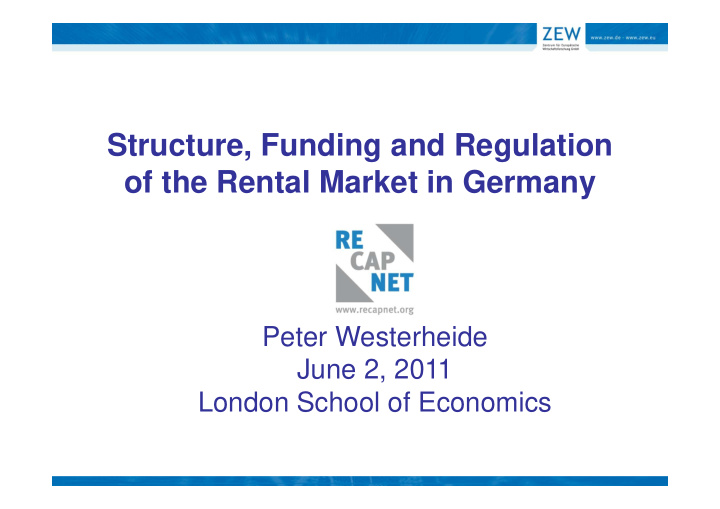



Structure, Funding and Regulation of the Rental Market in Germany Peter Westerheide June 2, 2011 London School of Economics
Contents • Structure of the Rental Sector • Funding • Regulation • Why does work there and not here? 2
Structure of the Rental Sector • 61 per cent of the total rental sector (no. of flats) are owned by small private landlords Source: GdW 2008, University of Mannheim, Data refer to 2006 3
Structure of the Rental Sector • Social Structure of Landlords Differs Strongly from Average With w./o. rental rental income income Pre- 56k 28k government income HH (Mean, Euro) Post- 48k 24k government income HH (Median, Euro) Age (Median, 59 51 Years) Source: GSOEP, Wave 2009, own calculations 4
Investment Motives of Private Landlords Source: BBR 2007, Data refer to West Germany Scale from 5 (very important) to 0 (totally unimportant) 5
Funding (I) • No detailed figures on funding of purchases/construction • Stylized facts: − High equity ratios − Inclusion of debt predominantly because interest is tax deductible against other sources of income − Use of subsidies for energy saving measures and other subsidized investment purposes 6
Funding (II) • Financing Structure for Investments in the Building Stock Source: BBR 2007, Data refer to West Germany (Caution: small sample!) 7
Regulation (I) • Strong regulation towards high security of tenure • Contracts are usually unlimited • Landlord must prove legitimate interest to evict tenant − breach of contractual obligations − delay of payment − own use by landlord (particularly hard to prove if landlord is owner occupier) 8
Regulation (II) • Strong regulation against prohibitive rent increases and rent levels − increase to a level not higher than average level (of rents in new contracts from the last 4 years) − increase by not more than 20 percent in 3 years − not more than 11 percent of costs for energy saving measures may be passed to tenants per year − usury laws: rent (even for new contracts) may not exceed local level by more than 50 percent. 9
Regulation: Why does it work there and not here? • Mentality of tenants − Culture of renting instead/as an alternative of owning: Hard to understand how this developed, but renting is not stigmatised. − Legacy of subsidised (social) housing after WW2: parents/grandparents living in rented flats is considered as normal − Germany is not monocentric but has at least 5 big business centres (Berlin, Frankfurt, Munich, Duesseldorf, Hamburg) and a lot of smaller ones: Young professionals with partners tend to commute weekly from their workplace to their partners’ home (“remote distance partnerships”): supported by excellent infrastructure (in international comparison) 10
Regulation: Why does it work here and not there? • Mentality of landlords − Long term investment motives dominate − Residential investment as inflation hedge − Retirement provision − Security of tenure matches long term investment motives of landlord: Keep a good tenant as long as you can! 11
Probably a relict of good old „social market economy“... 12
Recommend
More recommend